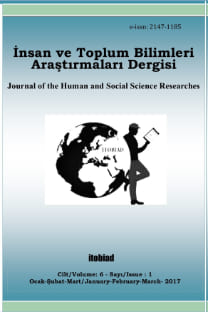Lise Öğrencilerinin Sınıf Dışı İngilizce Kullanımlarının İncelenmesi: Bir Anket Geliştirme Çalışması
Sınıf Dışı İngilizce, Yabancı Dil Olarak İngilizce
Investigating High School Students' Use of Extramural English: A Scale Development Study
Extramural English, English as a Foreign Language,
___
- EF Education First. (2014, 2015, 2016). EF EPI English proficiency index. Retrieved from http://www.ef.com.tr/epi/regions/europe/
- Freed, B. F. (1995). What makes us think that students who study abroad become fluent? In B. F. Freed (ed.), Second language acquisition in a study abroad context (pp. 123-148). Amsterdam: John Benjamins.
- Gao, X. (2006). Strategies Used by Chinese Parents to Support English Language Learning. RELC, 37(3), 285-298.
- Grau, M. (2009). Worlds apart? English in German youth cultures and in educational settings. World Englishes, 28(2), 160-174.
- Hair J. F., Tatham R. L., Anderson R. E. & Black W. (1998). Multivariate Data Analysis, Prentice Hall, New York.
- Hyland, F. (2004). Learning autonomously: contextualizing out-of-class English language learning. Language Awareness, 13(3), 180-202.
- Ibadurrahman, I. (2011). Out-of-class language learning: Case study of Indonesian senior high students in Bandung. Retrieved from: http://www.slideshare.net/IhsanIbadurrahman/lit-review-10281266
- Jourdain, R. (1998). Music, the brain, and ecstasy: How music captures our imagination. New York: Harper Collins.
- Kalaycı, Ş. (2010). SPSS Uygulamalı Çok Değişkenli İstatistik Teknikleri. Asil Yayınları, Ankara.
- Kuppens, A. H. (2010). Incidental foreign language acquisition from media exposure. Learning, Media and Technology, 35 (1), 65–85.
- ISSN: 2147-1185
- Yayın Aralığı: 4
- Başlangıç: 2012
- Yayıncı: Mustafa SÜLEYMAN ÖZCAN
Sınıf Öğretmenlerin Perspektifinden Değerler Eğitiminin İncelenmesi: Erzurum Örneği
Amerika Birleşik Devletleri'nin Yumuşak Gücü ve Hollywood
Lise Öğrencilerinin Sınıf Dışı İngilizce Kullanımlarının İncelenmesi: Bir Anket Geliştirme Çalışması
ABDULLAH COŞKUN, HAKAN TAHİRİ MUTLU
Balkanlarda Bektaşilik ve Bektaşi Tekkeleri
Tuba ÇİBİK HATİPLER, FİLİZ UMAROĞULLARI
İNSAN VE TOPLUM BİLİMLERİ ARAŞ
7. Yüzyılda Harem-i Şerif’te Bir Sinagog: Tarihi Bir Gerçeklik mi Hayal mi?
Türk Modernleşmesi'nin Bir Projesi: Modern Türk Müziği
7. Yüzyılda Harem-i Şerif'te Bir Sinagog: Tarihi Bir Gerçeklik mi Hayal mi?1
MUSTAFA YİĞİTOĞLU, MUSTAFA YİĞİTOĞLU
Sosyal Medyada Kulaktan Kulağa İletişime Yönelik İhtiyacın Marka Bağlılığına Etkisi
